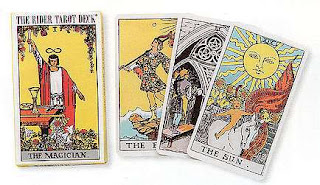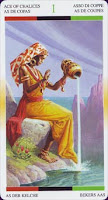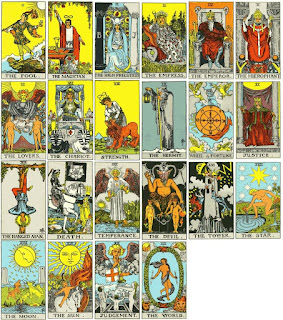Divination 101: Taromancy
 |
| The Rider-Waite Tarot is the most popular divination deck worldwide |
History
Taromancy, or tarot reading, originated in 15th Century Italy as a game called tarocchi. Many Europeans played similar games with pictorial cards in France and Germany, and in some regions, the tradition continues. Similar to tarot games, though more akin to bingo, lotería playing cards in Mexico depict allegorical figures and have cartomancy applications as well.
The Visconti-Sforza playing deck, commissioned by the Duke of Milan in 1415, is considered the original model for all subsequent tarot cards. The Tarot de Marseille borrowed from the Visconti and introduced the Italian suits to France, where the style eventually spread to Britain and America.
The original French suits (Hearts, Diamonds, Spades, and Clubs) became the widely-used system for American and British playing cards, while the Latin suits (Cups, Coins, Swords, and Wands) used in Italy were adopted by occultists for divination cards. In America and Britain, "tarot" is synonymous with cartomancy, but in many European cultures, the cards are still considered games.
Following the British occultist movement of the 1800s, secret societies like the Hermetic Order of the Golden Dawn adopted the Tarot de Marseille for divination purposes. Mystics like A. E. Waite and Aleister Crowley based their cards on the traditional Italian suits, producing the Rider-Waite Tarot (1910) and the Book of Thoth (1944), decks considered foundational to Western divination traditions.
The Visconti-Sforza playing deck, commissioned by the Duke of Milan in 1415, is considered the original model for all subsequent tarot cards. The Tarot de Marseille borrowed from the Visconti and introduced the Italian suits to France, where the style eventually spread to Britain and America.
The original French suits (Hearts, Diamonds, Spades, and Clubs) became the widely-used system for American and British playing cards, while the Latin suits (Cups, Coins, Swords, and Wands) used in Italy were adopted by occultists for divination cards. In America and Britain, "tarot" is synonymous with cartomancy, but in many European cultures, the cards are still considered games.
Following the British occultist movement of the 1800s, secret societies like the Hermetic Order of the Golden Dawn adopted the Tarot de Marseille for divination purposes. Mystics like A. E. Waite and Aleister Crowley based their cards on the traditional Italian suits, producing the Rider-Waite Tarot (1910) and the Book of Thoth (1944), decks considered foundational to Western divination traditions.
Variations
 |
| The Rider-Waite Tarot Deck |
The Rider-Waite Tarot, considered the best deck for beginners, set the modern standard for all interpretations to follow. Traditional decks based on this model comprise of 78 cards divided into the Major and Minor Arcana, and feature variations on the same archetypal figures and the four suits: Wands, Cups, Swords, and Coins.
The Thoth Tarot, perhaps the most popular deck after the Rider-Waite, varies widely from this model, and could be considered its own system. Crowley based it on Ancient Egyptian mythology under the false impression that tarot originated there. (Bare in mind that Crowley was a vocal anti-Semetist and Nazi sympathizer, despite the fact that he appropriated elements of Jewish mysticism in his practice, and his work should be viewed critically.)
 |
| The African American Tarot depicts figures from various African myths |
Some tarot artists update the the white heterosexual male default of the Rider-Waite model and create decks that center people of color, replace male figures with women, or use same-gender couples for the Lovers card. Some examples of diverse decks include:
- African American Tarot
- Native American Tarot
- Japanese Tarot
- Chinese Tarot
- Goddess Tarot
- The Gay Tarot
Tarot is popular with creatives, and many decks exist for writers, poets, and artists:
Below, I've outlined the basic meanings of each card in the Major Arcana. Upright meanings are listed first; reversals follow after the slash. This brief guide is by no means representative of the depth of symbolism found in each card, nor does it go into the various meanings that arise when cards are combined in a specific spread. It's simply a quick reference for those new to tarot. Be sure to check which system your deck is based on and read the enclosed booklet for more details!
Amount: 22 cards (0 Fool – 21 The World)
Focus: archetypes, or universal concepts
The Major Arcana are considered foundational. They give general descriptions of a situation or problem and often describe important life events or changes.
I recommend only using the Major Arcana if
you’re new to tarot. With 78 cards total, an entire tarot deck can seem
daunting. Becoming familiar with the essential 22 can help build a solid foundation
to draw from once you graduate to more advanced spreads.
Read more about how to use the Major Arcana for writing here.
Read more about how to use the Major Arcana for writing here.
0. The Fool
1. The Magician2. The High Priestess
3. The Empress
4. The Emperor
5. The Hierophant
6. The Lovers
3. The Empress
4. The Emperor
5. The Hierophant
6. The Lovers
7. The Chariot
8. Strength
8. Strength
9. The Hermit
10. Wheel of Fortune
11. Justice
10. Wheel of Fortune
11. Justice
12. The Hanged Man
13. Death
14. Temperance
15. The Devil
15. The Devil
16. The Tower
17. The Star
18. The Moon
19. The Sun
20. Judgement
21. The World
Minor Arcana
Amount: 56 cards (4 suits of 16 cards each)The Minor Arcana exist to add context to the insights provided by the Major Arcana. They provide more details and subtle meanings and often describe day-to-day aspects of life.
I don't recommend using these cards in your readings until you're familiar with the Major set. Each card in a spread adds new meanings to the rest, so adding the Minor Arcana may complicate your readings if you're new to tarot. However, they're a great tool for unlocking details and understanding the context of the Major Arcana's symbolism.
Read more about how to use the Minor Arcana for writing here.
The Minor Arcana is divided into four suits, called pip cards, each with four court cards, which are similar to the face cards in playing card decks.
Pip Cards
- Cups (Chalices)
- Pentacles (Coins, Disks)
- Swords
- Wands (Staves)
Court Cards
- Pages
- Knights
- Queens
- Kings
Sources
Labyrinthos
Tarot.com
The Ultimate Guide to Tarot



Comments
Post a Comment